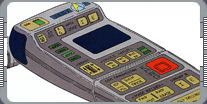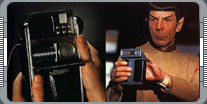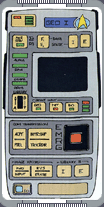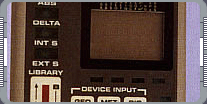
Designing Tricorders - By Rick Sternbach.
The tricorder has been an essential part of Star Trek since the series was launched in the 1960s.
When Star Trek: The Next Generation entered production, Rick Sternbach took the opportunity to design a
new version.
 The tricorder is truly a device born of centuries of scientific exploration, as well as the fictional
world of super-science. Early inventions measured weight, time and temperature, and later gave rise to
the wonderful zoo of laboratory instruments of the late 19th and early 20th century, constructed of
hand-blown glass, magnets, and wire coils. Devices were built to probe the atom, see through objects,
measure energy, and reveal the elements present in distant stars. All of the technological advances in
detecting mechanical and eletromagnetic energy, and processing them into useful data, have led to the
present-day mountain of devices we use to understand the world around us. We check on radiation leakage
from our microwave ovens. We detect dangerous levels of toxins. we monitor water pressure on deep-sea
dives, and in the vacuum of deep space. Man of these gadgets are multifuctional, handheld, and getting
smaller all the time.
The tricorder is truly a device born of centuries of scientific exploration, as well as the fictional
world of super-science. Early inventions measured weight, time and temperature, and later gave rise to
the wonderful zoo of laboratory instruments of the late 19th and early 20th century, constructed of
hand-blown glass, magnets, and wire coils. Devices were built to probe the atom, see through objects,
measure energy, and reveal the elements present in distant stars. All of the technological advances in
detecting mechanical and eletromagnetic energy, and processing them into useful data, have led to the
present-day mountain of devices we use to understand the world around us. We check on radiation leakage
from our microwave ovens. We detect dangerous levels of toxins. we monitor water pressure on deep-sea
dives, and in the vacuum of deep space. Man of these gadgets are multifuctional, handheld, and getting
smaller all the time.
 How did we arrive at the present version of the tricorder? The original series device, designed by Wah
Chang, was two-handed, with its flip-open screen and library disks. (predating floppies and flash ROM
cards) - very advanced for its day. The Star Trek feature films, beginning in 1978, saw an evolution of
smaller, sleeker sensors that kept pace with the growing computer revolution. Except for the occasional
bout of subspace interference, the tricorder could pinpoint locations, detect life forms, analyze energy
fields, warn of phaser fire, and predict seismic disaster. Many of today's scientific mechanisms and
much computer power were squeezed into a volume of roughly 15 cubic inches - a neat trick by any standard.
When we began Star Trek: The Next Generation in 1987, we had an opportunity to rethink a lot of the
personnel gear, including the tricorder, the communicator, and phasers. Gene Roddenberry asked us to
think in terms of smaller and sleeker, and, while fellow illustrator Andy Probert was busy detailing the
USS Enterprise NCC-1701-D, and Mike Okuda began reinventing
the Starfleet control interfaces, Sternbach worked up a number of tricorder designs and color specs.
How did we arrive at the present version of the tricorder? The original series device, designed by Wah
Chang, was two-handed, with its flip-open screen and library disks. (predating floppies and flash ROM
cards) - very advanced for its day. The Star Trek feature films, beginning in 1978, saw an evolution of
smaller, sleeker sensors that kept pace with the growing computer revolution. Except for the occasional
bout of subspace interference, the tricorder could pinpoint locations, detect life forms, analyze energy
fields, warn of phaser fire, and predict seismic disaster. Many of today's scientific mechanisms and
much computer power were squeezed into a volume of roughly 15 cubic inches - a neat trick by any standard.
When we began Star Trek: The Next Generation in 1987, we had an opportunity to rethink a lot of the
personnel gear, including the tricorder, the communicator, and phasers. Gene Roddenberry asked us to
think in terms of smaller and sleeker, and, while fellow illustrator Andy Probert was busy detailing the
USS Enterprise NCC-1701-D, and Mike Okuda began reinventing
the Starfleet control interfaces, Sternbach worked up a number of tricorder designs and color specs.
 Since the communicator evolved from the flip-open subspace radio to a one-piece Starfleet insignia badge,
we applied the idea of a protective cover to the tricorder, which had the added effect of making the
stowed unit small enough to fit into a uniform holster, ready for action. The display screen was sized
for a 35mm color transparency, to show bits of Starfleet graphics. The first model opened automatically,
by way of a tiny wind-up motor, and while the motor is gone, the sound effect remains. Custom circuit
boards, colored LEDs, tiny incandescent lights, and a narrow photo battery, all had to fit inside.
Since the communicator evolved from the flip-open subspace radio to a one-piece Starfleet insignia badge,
we applied the idea of a protective cover to the tricorder, which had the added effect of making the
stowed unit small enough to fit into a uniform holster, ready for action. The display screen was sized
for a 35mm color transparency, to show bits of Starfleet graphics. The first model opened automatically,
by way of a tiny wind-up motor, and while the motor is gone, the sound effect remains. Custom circuit
boards, colored LEDs, tiny incandescent lights, and a narrow photo battery, all had to fit inside.
The tricorder was painted a medium "engineering gray," which evolved into the present, deeper metallic
pewter tone. The 'controls' were designed to handle all sensing, analysis, and data transmission
fuctions. While most Starfleet systems use full-area touch screens, Sternbach made the controls as
separate button groups, to distinguish the tricorder from the Personal Access Display Device, or PADD.
Even if the camera didn't always see the control labels, it was a fairly simple matter to work them out,
given the knowledge of real space systems and science fiction design experience that we had to draw upon.
In some instances, our Visual Effects experts have added animation to the screen in a technique called a
'burn-in,' and one recent model of tricorder even employed a tiny LCD color television screen, which
allowed the prop more freedom of movement.
 Whatever our writers have needed the tricorder to do, it could do, and we've furnished technical notes
to them on its general operation and story-specific uses. Isolinear memory systems have been constantly
upgraded. The medical tricorder was given a peripheral device containing a pullout sensor, and
additional biomedical functions. A few other high-tech sensors were added to the basic unit, making it
part of a modular system. Twelve years after its initial appearance, the latest tricorder has undergone
a few more minor modifications in size and shape, but retains its recognizable form, with complex-looking
sensor lights and buttons. In the 24th century, surely this small device must be performing quadrillions
of readings and calculations per second! Of course, we have a few ideas about how to give the tricorder
an even more updated look and advanced capabilities, if and when the need arises. We can add
faster-than-light subprocessors, increase upload rate to 23.3 gigaquads per second, or sharpen the
resolution of the biosensors, if it will help our Starfleet people get out of a jam.
Whatever our writers have needed the tricorder to do, it could do, and we've furnished technical notes
to them on its general operation and story-specific uses. Isolinear memory systems have been constantly
upgraded. The medical tricorder was given a peripheral device containing a pullout sensor, and
additional biomedical functions. A few other high-tech sensors were added to the basic unit, making it
part of a modular system. Twelve years after its initial appearance, the latest tricorder has undergone
a few more minor modifications in size and shape, but retains its recognizable form, with complex-looking
sensor lights and buttons. In the 24th century, surely this small device must be performing quadrillions
of readings and calculations per second! Of course, we have a few ideas about how to give the tricorder
an even more updated look and advanced capabilities, if and when the need arises. We can add
faster-than-light subprocessors, increase upload rate to 23.3 gigaquads per second, or sharpen the
resolution of the biosensors, if it will help our Starfleet people get out of a jam.
 But remember, the real world is catching up to us daily - witness the comparsion of the Motorola
flip-phone to the original series communicator. In fact, an educational tool based on the TNG tricorder
prop, actually measures a number of enviromental factors. As designers of future technology, we think
we're pretty safe, but the tricorder, the 'Swiss Army knife' of the 24th century, may come to pass sooner
than we expect.
But remember, the real world is catching up to us daily - witness the comparsion of the Motorola
flip-phone to the original series communicator. In fact, an educational tool based on the TNG tricorder
prop, actually measures a number of enviromental factors. As designers of future technology, we think
we're pretty safe, but the tricorder, the 'Swiss Army knife' of the 24th century, may come to pass sooner
than we expect.
|
|
"DESIGNING TRICORDERS" - MAY 1999 ISSUE 1 STAR TREK: THE MAGAZINE COPYRIGHT OF PARAMOUNT PICTURES.
|